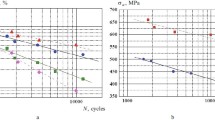Conclusions
-
1.
Steels 15Kh2NMFA and 15Kh2MFA are characterized by a reduction in FCR on the moderate-amplitude section of the fatigue curve with an increase in positive values of the cycle asymmetry coefficient, given the same values of Kmax, at room temperature.
-
2.
The nature of the effect of the compressive part of the load cycle on crack growth rate depends on the material and test conditions. Thus, for high-strength steel 15Kh3MA in the temperature range 213–293°K, FCR is the same in symmetrical and nonzero cycles. For steels of moderate strength (15Kh2NMFA), the compressive part of the load cycle has no effect on FCR at low temperatures (183–213°K), but the FCR is 1.5–2 times greater at R = −1 than at R = 0 when the temperature is increased to 293°K.
-
3.
Whereas steels 10GN2MFA and 15G2AFDps are characterized by a more rapid decrease in fracture toughness in symmetrical loading than with a nonzero cycle at 83 and 133°K, for steel 15Kh2NMFA an increase in R from −1 to 0.4 has no significant effect on the relation Kfc i-N.
-
4.
The fatigue fracture toughness Kfc 1 of steels 15Kh3MA, 15Kh2MFA, and 15Kh2NMFA increases with an increase in positive values of the cycle asymmetry coefficients. For steel 15Kh2NMFA in the range 183–213°K and for steel 15Kh3MA at 153°K, fracture toughness is roughly the same under symmetrical and nonzero loading conditions.
-
5.
For steel 15Kh2NMFA at 183 and 213°K, the critical SIF corresponding to final fracture is not sensitive to a change in the cycle asymmetry coefficient when R=-1–0.4.
Similar content being viewed by others
Literature cited
A. Oxta and E. Sasaki, “Influence of stress ratio on the threshold level for fatigue crack propagation in high strength steels,” Eng. Fract. Mech.,9, No. 2, 307–315 (1977).
T. Kruker, “Effect of the compressive part of a symmetrical loading cycle on fatigue crack growth in high-strength alloys,” Trans. ASME, No. 4, 8–11 (1971).
J. Weertman, “Rate of growth of fatigue crack calculated from the theory of infinitesimal dislocations distributed in a plane,” Proc. First Conf. Fracture, Sandai, Japan, Vol. 1 (1966), pp. 153–164.
R. O. Ritchie, “Near-threshold fatigue crack propagation in ultrahigh strength steel: influence of load ratio and cyclic strength,” Trans. ASME,99, No. 3, 195–204 (1977).
J. K. Musura and J. C. Radon, “The effect of stress ratio and frequency on fatigue crack growth,” Fatigue Eng. Mater. Struct.,1, No. 4, 457–470 (1979).
N. Shigemoto and F. Yasuyoshi, J. Soc. Mater. Sci. Jpn.,27, No. 302, 1103–1109 (1978).
V. T. Troshchenko, V. V. Pokrovskii, Yu. S. Skorenko, et al., “Effect of cyclicity of loading on the fracture toughness characteristics of steels,” Probl. Prochn., No. 11, 3–17 (1980).
P. V. Yasnii, “Method and results of the investigation of the development parameters for strain fractures with planar deflection under conditions of low and high temperatures,” Probl. Prochn., No. 5, 78–81 (1980).
V. T. Troshchenko, V. V. Pokrovskii, V. G. Kaplunenko, et al., “Effect of scale on the fracture toughness of heat-resistant steels,” Probl. Prochn., No. 10 (1982).
“American Society for Testing and Materials. Standard test method for plane-strain fracture toughness of metallic materials (E 399-74),” in: 1976 Annual Book of ASTM Standards, Pt. 10, Philadelphia (1976), pp. 471–490.
G. P. Cherepanov, “Brittle strength of pressure vessels,” Zh. Prikl. Mekh. Tekh. Fiz., No. 6, 90–101 (1969).
V. T. Troshchenko, P. V. Yasnii, V. V. Pokrovskii, and A. A. Popov, “Effect of temperature and load cycle asymmetry on the fatigue fracture toughness of steel 15Kh2NMFA,” Probl. Prochn., No. 10, 3–6 (1981).
V. T. Troshchenko, A. V. Prokopenko, and V. V. Pokrovskii, “Study of fatigue fracture toughness characteristics of metals. Report No. 1,” Probl. Prochn., No. 2, 8–15 (1978).
V. T. Troshchenko, P. V. Yasnii, and V. V. Pokrovskii, “Study of the laws of unstable crack growth under cyclic loading,” Probl. Prochn., No. 6, 3–7 (1980).
Author information
Authors and Affiliations
Additional information
Translated from Problemy Prochnosti, No. 11, pp. 29–34, November, 1982.
Rights and permissions
About this article
Cite this article
Yasnii, P.V., Pokrovskii, V.V., Kaplunenko, V.T. et al. Effect of loading-cycle asymmetry on the crack resistance of structural alloys. Strength Mater 14, 1456–1461 (1982). https://doi.org/10.1007/BF00768939
Received:
Issue Date:
DOI: https://doi.org/10.1007/BF00768939




